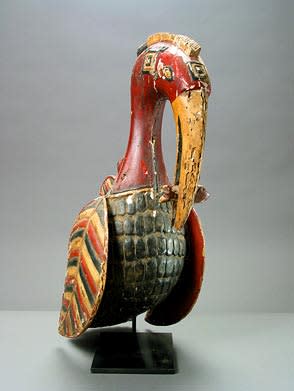Baga Wooden Polychrome Sculpture of a Bird, 20th Century CE
Wood and Paint
9 x 23.25
PF.4810
Further images
The Baga live around the marshy lagoons of the coastal region of Guinea. For six months of the year the land is flooded, which effectively cuts them off from the...
The Baga live around the marshy lagoons of the coastal region of Guinea. For six months of the year the land is flooded, which effectively cuts them off from the rest of the world. The women of the villages are the ones who plant rice in these swampy areas, and it is through the female element of nature that the Baga rituals are connected. Birds are used as a symbol of this fertility, particularly in the great Nimba masks that are made for festivals pertaining to the fertility of the fields and women.
This handsome bird was part of agricultural ceremonies for the cultivation of rice. It is very realistic in style, with its long, curved beak holding a fish, and the gentle sweep of the multi-colored wing feathers. Yet, there are symbolic elements seen in the tattooing on the sides of the head and forehead, and the unexpected “house” on the bird's back. The two adorable babies are beautifully crafted, especially in the expressive quality of the top bird that is biting into a snake crawling up the mother's neck. What we are seeing here is a cycle of life blossoming with richness and vitality, of healthy young with plenty of food from land and water, of both mother and offspring very content in a self-regenerating environment. At the center is the village that benefits from the abundance of nature, and rests securely on the back of mother-earth in the form of a bird. Apart from its symbolic meaning, this sculpture is a graceful work of art that makes us aware of the dignity of nature and our struggle to appease the forces that rule us.
This handsome bird was part of agricultural ceremonies for the cultivation of rice. It is very realistic in style, with its long, curved beak holding a fish, and the gentle sweep of the multi-colored wing feathers. Yet, there are symbolic elements seen in the tattooing on the sides of the head and forehead, and the unexpected “house” on the bird's back. The two adorable babies are beautifully crafted, especially in the expressive quality of the top bird that is biting into a snake crawling up the mother's neck. What we are seeing here is a cycle of life blossoming with richness and vitality, of healthy young with plenty of food from land and water, of both mother and offspring very content in a self-regenerating environment. At the center is the village that benefits from the abundance of nature, and rests securely on the back of mother-earth in the form of a bird. Apart from its symbolic meaning, this sculpture is a graceful work of art that makes us aware of the dignity of nature and our struggle to appease the forces that rule us.









